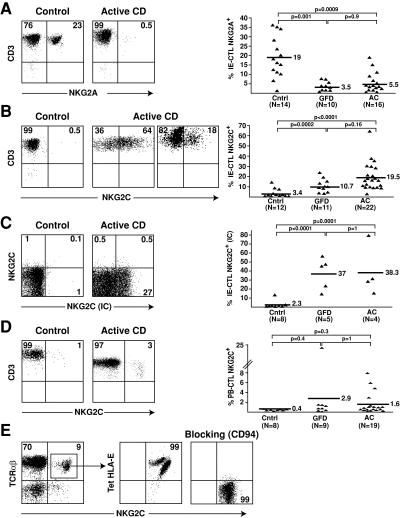Figure 1.
Selective expansion of IE-CTLs expressing activating CD94/NKG2C receptors in celiac disease. Representative flow cytometric data on freshly isolated TCR-αβ+CD8+ IE-CTLs or PB-CTLs from normal controls (Cntrl), AC patients, and celiac patients on a GFD are shown in the right panels. A scatter plot graph summarizing all samples investigated is shown on the right in A–D. (A) Decreased frequency of IE-CTLs expressing inhibitory CD94/NKG2A receptors in AC patients and GFD patients. (B) Increased frequency of IE-CTLs expressing surface CD94/NKG2C receptors in AC patients and GFD compared with controls. (C) Increased frequency of IE-CTLs expressing intracellular NKG2C protein (NKG2C IC) in AC patients and GFD compared with controls. (D) Propensity toward an increased frequency of PB-CTLs expressing surface CD94/NKG2C receptors in AC patients and GFD compared with controls. (E) CD94-dependent HLA-E recognition by CD94/NKG2C+ CTLs. A representative example of HLA-E staining on gated TCR-αβ+CD8+ NKG2C+ CTLs is shown on freshly isolated PBLs. Left panel shows that incubation with anti-CD94 antibody before incubation with a HLA-E tetramer prevents staining with the HLA-E tetramer.

